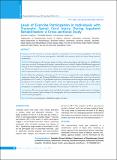Please use this identifier to cite or link to this item:
https://hdl.handle.net/20.500.14356/1033Full metadata record
| DC Field | Value | Language |
|---|---|---|
| dc.contributor.author | Adhikari, Shambhu Prasad | - |
| dc.contributor.author | Adhikari, Shraddha | - |
| dc.contributor.author | Rana, Chanda | - |
| dc.contributor.author | Dev, Rubee | - |
| dc.date.accessioned | 2023-04-20T07:19:08Z | - |
| dc.date.available | 2023-04-20T07:19:08Z | - |
| dc.date.issued | 2021 | - |
| dc.identifier.citation | AdhikariS. P., AdhikariS., RanaC., & DevR. (2021). Level of Exercise Participation in Individuals with Traumatic Spinal Cord Injury During Inpatient Rehabilitation: A Cross-sectional Study. Journal of Nepal Health Research Council, 19(1), 32-38. https://doi.org/10.33314/jnhrc.v19i1.2912 | en_US |
| dc.identifier.issn | Print ISSN: 1727-5482; Online ISSN: 1999-6217 | - |
| dc.identifier.uri | http://103.69.126.140:8080/handle/20.500.14356/1033 | - |
| dc.description | Original Article | en_US |
| dc.description.abstract | Abstract Background: The outcome of exercises depends on participants’ level of exercise participation. We aimed to investigate the level of exercise participation in individuals with traumatic spinal cord injury during inpatient rehabilitation. Methods: All participants with traumatic spinal cord injury undergoing inpatient physiotherapy at a rehabilitation center were recruited. Participants with hearing/visual problems were excluded. Hopkins Rehabilitation Engagement Rating Scale and Pittsburgh Rehabilitation Participation Scale were used to evaluate exercise participation levels. One-way ANOVA and unpaired t-test were used to compare level of participation between groups. Pearson’s correlation and Chi-square tests were used to evaluate correlation and association. Results: Thirty-five participants with mean age 37.1 ± 11.7 years completed the study. Hopkins Rehabilitation Engagement Rating Scale and Pittsburgh Rehabilitation Participation Scale demonstrated a low level of exercise participation in 31.4 % and 42.9 % participants respectively. Participants with an incomplete injury had high exercise participation levels compared to complete injuries. There were significant group differences (p < 0.001, effect size = 0.8) between complete and incomplete injuries and among various levels of injuries. The level of exercise participation was significantly associated with injury levels and type (p < 0.001, Phi = 0.7 to 0.9). Conclusions: The exercise participation level was high for incomplete compared to complete injuries in Nepalese individuals with traumatic spinal cord injury. The demographic and socio-economical factors were not associated with level of exercise participation. Keywords: Exercise participation; rehabilitation; spinal cord injury | en_US |
| dc.language.iso | en | en_US |
| dc.publisher | Nepal Health Research Council | en_US |
| dc.relation.ispartofseries | Jan-March, 2021;2912 | - |
| dc.subject | Exercise participation | en_US |
| dc.subject | Rehabilitation | en_US |
| dc.subject | Spinal cord injury | en_US |
| dc.title | Level of Exercise Participation in Individuals with Traumatic Spinal Cord Injury During Inpatient Rehabilitation: A Cross-sectional Study | en_US |
| dc.type | Journal Article | en_US |
| local.journal.category | Original Article | - |
| Appears in Collections: | Vol. 19 No. 1 (2021): Vol. 19 No. 1 Issue 50 Jan-Mar 2021 | |
Files in This Item:
| File | Description | Size | Format | |
|---|---|---|---|---|
| 2912-Manuscript-21543-1-10-20210425.pdf | Fulltext Article. | 324.41 kB | Adobe PDF |  View/Open |
Items in DSpace are protected by copyright, with all rights reserved, unless otherwise indicated.
